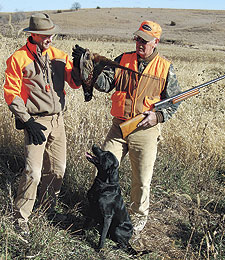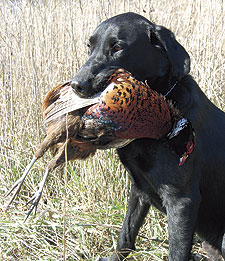...And Taking It up Again.
By Chad S. Mason
 Sometimes the author (left) likes to let friends do the shooting. |
A strange transformation happened to me on November 20, 2008. Until that day, I had never followed one of my dogs during the hunting season without carrying a gun. But that day I changed, unexpectedly and without explanation, from a man who almost needed to gun birds, into a man who had to be coaxed into shooting. Only time will tell if the change is permanent, or just a passing phase.
Four friends from Kentucky had called to say they were coming to Iowa to hunt pheasants, and we arranged to meet for an early breakfast. Dad would come down, too, and we would all hunt together--six men and two dogs. Without really thinking about it, I woke up that morning and just decided to handle the dog and not carry a gun.
"Where's your gun?" Dad asked while I put my dog and camera into his truck.
"I decided not to bring one," I said. It sounded weird, even to me, when I said it out loud.
We met the Kentuckians at the old converted schoolhouse where they bunk every November, about 50 miles west of my house. A cold wind was blowing out of the northwest, about 20 miles an hour, adding even more bite to the sub-freezing temperature.
Inside the old schoolhouse, though, the air was warm enough to redden your face, and heavy with the smells of sausage, biscuits, gravy, scrambled eggs and coffee. I brought in a dozen fresh donuts, not because anybody needed them but because I don't like to meet good people empty-handed. That goes double for good people who have permission to hunt good land. Maybe I should've brought two dozen.
After breakfast, we drove half a mile up the road to the first rippling hills of brome and switchgrass between fields of late-standing corn. When I came out unarmed, there were some quizzical looks and then some questions.
I said I didn't bring a gun because that's the only way I can be sure not to embarrass myself. It was a lame excuse, the kind you make when you feel awkward about what you're doing and worried that others won't understand, because you're not sure that you understand it yourself.
We had two dogs on the ground. My Lab, Woody, was thrashing the heavy stuff inside 25 yards. My father's English setter, Jack, was running the edges, far enough away to look small. Both dogs were doing what they were made to do, and I was glad to be watching them.
Maybe 10 minutes out of the truck, Woody put up a rooster directly in front of me. The bird flared out like a great dancing Chinese kite with his chest toward me, so close that I could see his gray feet tucked against his black flanks and tell the difference between his wattles and his eyes. It would have been an easy shot. Then the bird peeled downwind, straight away from me, and the man to my right missed him three times.
We trudged on. I was enjoying the freedom of two empty hands, warm inside my jacket pockets. With no vest full of ammo, I felt totally unencumbered by dead weight. Just a plastic whistle in my teeth and a water bottle in a belt pouch were all that I carried, besides myself inside my clothes.
 Woody, the author's Labrador, with a wild Iowa rooster. This is how every hunt story should end, but sometimes they don't. |
That succession of hills and swales did not produce a great number of pheasants--nothing like the Iowa of old memories, but enough to keep us all interested, and certainly more than you can find anywhere in Kentucky. The standing corn probably didn't help anything.
With our legs warmed up, we returned to the trucks and one of the Kentuckians mentioned a good patch of habitat up the road where the corn was just harvested yesterday. When we reached the place, I was prepared again to walk unarmed. But someone urged me otherwise.
"Are you sure you don't want to carry a gun," he said. "I've got an old 1100 here in the truck."
"No, but thanks," I said.
"Really, I don't mind," he persisted.
"All right," I finally relented. He handed me the old Remington, and Dad stuffed two handfuls of shells into my jacket pockets. In five minutes my fingers were cold.
From there we stepped on logs felled by beavers to ford a creek flowing high in its grassy banks. Then we marched toward brome-covered hills dotted with clumps of juniper. In the slumping crags between the hills, twisted trees and multiflora rose made fortresses where deer abandoned their beds at our approach. Somewhere on the back side of the fourth hill, along a fence that separated grass from a grazed-out cow pasture, Jack went on point.
I circled around in front of Jack to flush the bird back away from the cows, and toward the Kentuckians. It came out cackling, flying low across the smooth green hillside toward the distant corn stubble. What sounded like a single blast rang out and the bird folded, but two men said, "Got him!" I was one of them.
The bird lay in plain view on the bare pasture, his tail feathers raised by the wind. A welded rod fence separated us from the bird, so I lifted 65 squirming pounds of Labrador retriever almost over my head and dropped Woody into the pasture. Woody raced to the bird, snatched it up, and delivered it to hand. Then he reared up with his front paws on the fence to be hauled over again.
The bird was almost absurdly beautiful, a young and delicate rooster with brilliant colors and not a feather missing. Every angle showed a new iridescence and every color flowed perfectly into the next as if expertly painted. I would have thought the bird was made of porcelain had I not felt its fading warmth and softness in my own hand. I gave it to the other man who had fired, and put another shell in the old 1100.
Down through a brushy creek bottom, and out the other side to a field of corn stubble, I paused to pick the cockleburs off my whistle lanyard. Jack was running a line up a grassy waterway in the stubble, and I was watching him from the edge of the woods. The rest of the party stayed back on the other side of the creek, not wanting to navigate its vertical banks.
Woody was doing his job behind me, shaking the tall horseweeds with his excited ta
il. I heard a cackle, and turned to see a rooster flying off the end of Woody's nose.
The bird careened in a windblown arc across the open stubble, gaining altitude and speed. The old 1100 was hard to get moving, but just as hard to stop once it started to swing. It kept on swinging through the blast, and the bird fell dead among the broken stalks. Woody brought it to hand, and it was just as beautiful as the first. I was glad that I had been carrying the old 1100.
On the way back to the trucks, a rooster flushed wild and flew high above the brome. We watched it land on the far side of a brushy draw, 300 yards away. While the other men continued toward the trucks, Dad and I decided to go for it.
Minutes later we reached the general vicinity and let the dogs go to work. Woody was crashing the brush down in the draw to my right when he suddenly lifted his nose high and turned toward me. He came up out of the draw, passed behind me, and began quartering into the open grass to my left.
Soon he paused with his ears perked, and then he lunged forward. The rooster came out cackling, flying straight away. From that angle, a pheasant is easy to hit but hard to kill. I hit it, but didn't kill it. The bird fell to earth with a broken wing and perhaps other less visible injuries, but with two uninjured legs.
Obviously, Woody has a good nose. He had detected the bird on the breeze from perhaps 30 yards away, and followed the scent plume to its source. Moreover, he marked the fall almost perfectly. This story should end with a live bird in a Labrador's mouth, but it doesn't end that way. It ends with two puzzled men stamping all over a hillside with two good dogs that don't understand why they can't smell the bird they just saw.
I thought about the bird racing panicked through the brome, dragging a wing and dying slower than it deserved, and I wished that I had kept my hands in my pockets.
A friend of mine trains gun dogs for a living. Recently, after we had shot limits of pheasants in South Dakota, he told me that he wasn't sure if he could stand to keep on training dogs. I was expecting him to go on about picky owners and their unreasonable demands, so his reason struck me hard.
"I'm tired of the killing," he whispered. "Every day, all day long, I shoot pigeons or twist their necks. God help me, some days I don't think I can kill another one."
There were other hunters present, and he spoke quietly, as though afraid others might overhear us. I wondered then, and still wonder now, whether the state of hunting today is healthy if a hunter feels afraid to speak out loud of his reticence about killing.
For the record, I am not done killing pheasants. But I don't need to kill them anymore, and their deaths bother me more than they once did, especially when they don't go according to script. Maybe that's because pheasants are getting scarcer--and thus more precious--where I live, or maybe it's because I'm getting older. Either way, I look forward to more opportunities to handle the dogs and let others do the shooting. I hate cold fingers.






